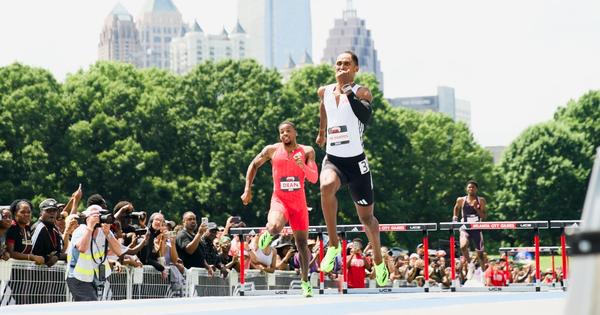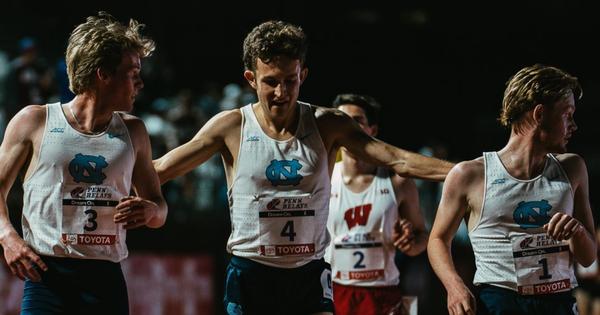By David Melly
June 4, 2025
Last week, Jakob Ingebrigtsen dropped a video—and some wisdom—to his Instagram.
He’s chin-deep in water, aquajogging during his rehab for an Achilles flare-up that’s kept him out of races for most of the spring. Over a grainy film filter and trippy background instrumental, he offers a quasi-philosophical musing on the nature of pain.
“Remember,” he pants, “it’s not the pain that kills you. It’s the realization of pain… so you just have to turn off and not realize that you’re in pain. Then you will be able to do the things you like… with high quality and success.”
He pauses, struggling to stay afloat and let his moribund fortune-cookie sentiment land. “I just—I just made that up,” he concludes, then bursts out laughing.
The video itself isn’t particularly visually remarkable and the words themselves are, frankly, nonsense. Jakob isn’t an infrequent poster, nor is he a stranger to video content (he has a YouTube channel with 70,000 subscribers and has been the subject of at least two reality TV series). But that 35-second clip perfectly encapsulates the off-camera phenomenon that is Jakob Ingebrigtsen, Media Personality: a strange mix of positivity, ego, and zen-like focus, simultaneously cold and goofy, and determined to communicate something—even if it’s not always clear what or why—with his audience.
Regular readers will know that the public perception of Jakob and his closest rivals is a source of endless fascination for the Lap Count crew. On paper, Ingebrigtsen should be easily cast as the villain: a cocky wunderkind with all the resources that Nike and the Kingdom of Norway can provide, complete with a regal air and high and tight hairstyle. Doggedly convinced of his own greatness, but irritable and defensive in response to the lightest criticism. This guy is the Draco Malfoy of track and field, right? Why does anyone like him?
And yet, they do. Ingebrigtsen has scores of passionate fans, tweeting fan cams, nicknaming him “Babygirl,” and rushing to his defense at any perceived slight. All the greatest athletes have one thing in common: their stans are as vocal and passionate as their haters. Jakob may not be quite as popular as LeBron James, or Caitlin Clark, or Tom Brady, but he shares their ability to both inspire and polarize. And that’s an ability that can’t come solely from performance on the track: it results from the things he says and does before and after a race.
Jakob Ingebrigtsen is not the most universally beloved track athlete, nor the most followed, but he’s one of the sport’s strongest communicators. He (and those around him—let’s not forget that athletes’ personalities would be much more of a mystery without photographers, videographers, producers, and sports journalists) is remarkably effective at painting a clear picture of himself that evokes a strong response from the track and field audience. It’s not always a positive response, but the net result is inarguably good: it’s not hard to get a sense of Jakob’s personality, his thinking, and how he interacts with the world. The first step to loving someone is to know them.
Despite the resurgence of the sports documentary as a form, and the explosion of running content on YouTube, the clearest conduit from athlete to fan remains social media. What is it, exactly, that makes some sports personalities better at harnessing the platform than others?
Despite an increasingly blurry line, there remains an important distinction between an athlete using social media to further their career and an athlete becoming a social media influencer. It can be hard to distinguish one from the other, but a simple way is to follow the money. If an individual’s primary source of income depends on their performance, they’re an athlete with a media presence. If their main business is media, they’re an influencer. Nick Symmonds may have once been paid primarily to run 800ms, but that’s not what his 2024 tax return would indicate.
Being a runfluencer is ultimately a different thing, but the backlash often sparked by a late-career pivot from “runner with product endorsements” to “product endorser who also runs” is telling. Because the most precious commodity for an athlete in the public eye isn’t attractiveness, or humor, or even relatability. It’s authenticity.
When it comes to sports fandom, people’s bullshit sensors are surprisingly fine-tuned. They don’t like the feeling of being lied to, or misled, or hard-sold. Perhaps this is why doping offenses elicit such a strong emotional reaction from large swaths of the track and field community: it’s not simply the injustice of cheating at a system that’s supposed to be fair; it’s hiding the true nature of a performance from the public.
Authenticity is not a value judgment—people can be deeply and authentically unlikeable. But it’s human nature to try and bridge the gap between a fan sitting on their couch and an athlete standing on the starting line with some sense of connection, and that’s where social media comes in.
Track and field is full of great personalities. But some are better than others at sharing that personality with the world. Craig Engels isn’t just a fan favorite for his mustache and mullet; it’s his willingness to share a race day vlog with the caption “Try to count how many times I pooped.” Gabby Thomas has surely won more friends than enemies for her willingness to clap back at trolls on Twitter. And Anna Hall’s 7000-point performance at Gotzis was made all the sweeter because fans were with her for every painful step back from her 2024 surgery.
Of course, it cuts both ways. Just as public sentiment seems to have shifted in Jakob’s favor, it feels like Josh Kerr has picked up more detractors at the same time. There are many factors at play, many of which are the very same qualities and dynamics the two rivals share: a healthy ego, unabashedly high goals, expensive-looking haircuts, and a willingness to comment obliquely or even directly about one another. But one contributing factor very well could be Kerr’s handing off the reins of his social media accounts to professionals sometime in 2023, a change he attributed at the time to prioritizing his training and mental focus. The result, however, was a noticeable change in the tone and style of his Instagram posts to curated model shots with SEO-friendly hashtags like “#athletemotivation” and “#joshkerr.”
Other athletes have faced similarly negative reactions when fans feel they’re being duped. While Kenny Bednarek remains a popular and closely-followed figure on the GST circuit, the widespread rumors that his camp was behind an anonymous Twitter account hasn’t helped his public image. Shelby Houlihan’s burrito saga did irreparable damage to the brand and reputation of an athlete who was previously known for her love of French bread and Harry Potter. And we can’t forget when Camille Herron got caught with her hand in the Wikpedia cookie jar, editing positive mentions of herself and negative mentions of other runners into articles.
What, if anything, professional athletes “owe” to fans in terms of access and transparency is a complicated discussion. But it’s clear that the most successful sportspeople online are those who are able to successfully harness the platforms at their disposal to tell their story in a way that galvanizes strong emotions and ultimately, a strong sense of attachment from viewers and fans.
At the end of the day, the golden goose for athletes isn’t keeping things positive, or informative, or funny. It’s simply keeping it real.

David Melly
David began contributing to CITIUS in 2018, and quickly cemented himself as an integral part of the team thanks to his quick wit, hot takes, undying love for the sport and willingness to get yelled at online.




